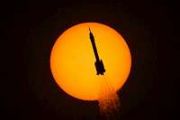
Copernical Team
Replay: HydroGNSS launch coverage
 Video:
01:45:00
Video:
01:45:00
ESA’s first Scout mission, HydroGNSS, was launched on 28 November 2025, marking a significant step in advancing global understanding of water availability and the effects of climate change on Earth’s water cycle.
The two twin HydroGNSS satellites were carried into orbit aboard a SpaceX Falcon 9 rocket from the Vandenberg Space Force Base in California, US.
Embracing the New Space concept, HydroGNSS is one of ESA’s new Scout missions being developed within the Earth Observation FutureEO programme.
CM25: A historic step forward for Europe’s space technology leadership

The ESA Council at Ministerial Level (CM25) delivered a record-breaking €22.1 billion in commitments from Member States. This is a historic achievement and a clear signal of trust in ESA’s ability to deliver success through expertise and innovation.
HydroGNSS launch highlights
 Video:
00:02:51
Video:
00:02:51
ESA’s first Scout mission, HydroGNSS, was launched on 28 November 2025, marking a significant step in advancing global understanding of water availability and the effects of climate change on Earth’s water cycle.
The two twin HydroGNSS satellites were carried into orbit aboard a SpaceX Falcon 9 rocket from the Vandenberg Space Force Base in California, US.
Embracing the New Space concept, HydroGNSS is one of ESA’s new Scout missions being developed within the Earth Observation FutureEO programme.
Follow the Galileo launch (L14) campaign

On 17 December, two Galileo satellites will be launched on Ariane 6 from Europe’s Spaceport in French Guiana in the 14th operational launch of the Galileo programme. These satellites will improve the precision, availability and robustness of the Galileo system by adding spares to guarantee the system can always provide a navigation signal for users worldwide. This will be Galileo’s first launch on Ariane 6 and the fifth launch of Europe’s heavy-lift launcher.
Week in images: 24-28 November 2025

Week in images: 24-28 November 2025
Discover our week through the lens
US-Russian crew of 3 starts 8-month mission on the International Space Station
Verifying that you are not a bot
Russian cosmodrome damaged after joint launch with US
Verifying that you are not a bot
Europe chooses resilient and secure space-enabled connectivity with €2.1 billion investment

In a time of profound technological and geopolitical challenges, Europe will continue to support the need for secure satellite communications. This was the clear message given at the European Space Agency's (ESA) Council meeting at Ministerial Level, in Bremen, Germany.
Earth from Space: Eye of the Sahara
 Image:
The Copernicus Sentinel-2 mission captures a spectacular geological wonder in the Sahara Desert of Mauritania: the Richat Structure.
Image:
The Copernicus Sentinel-2 mission captures a spectacular geological wonder in the Sahara Desert of Mauritania: the Richat Structure. European Space Agency boosts budget to catch up in space race
Verifying that you are not a bot































